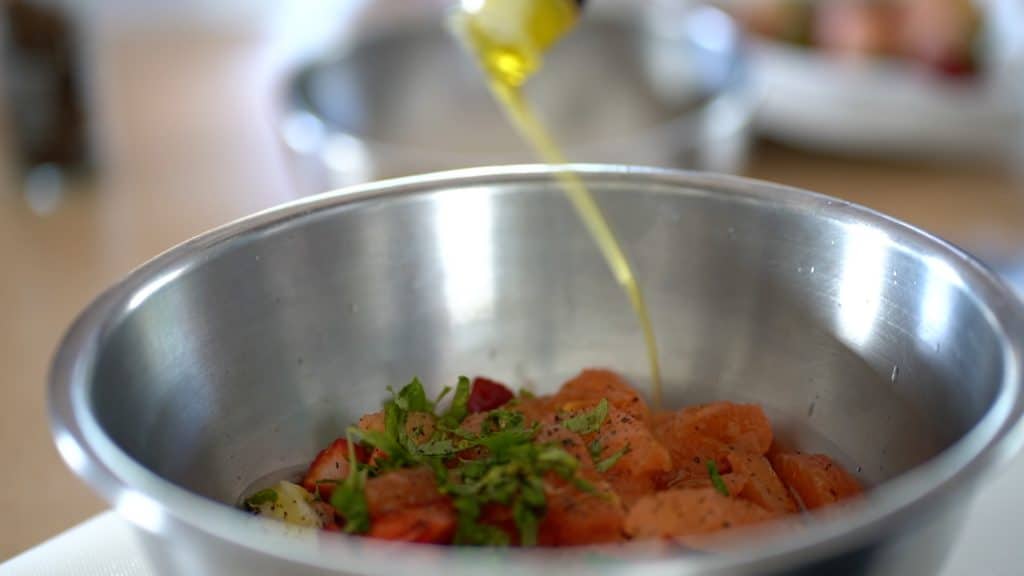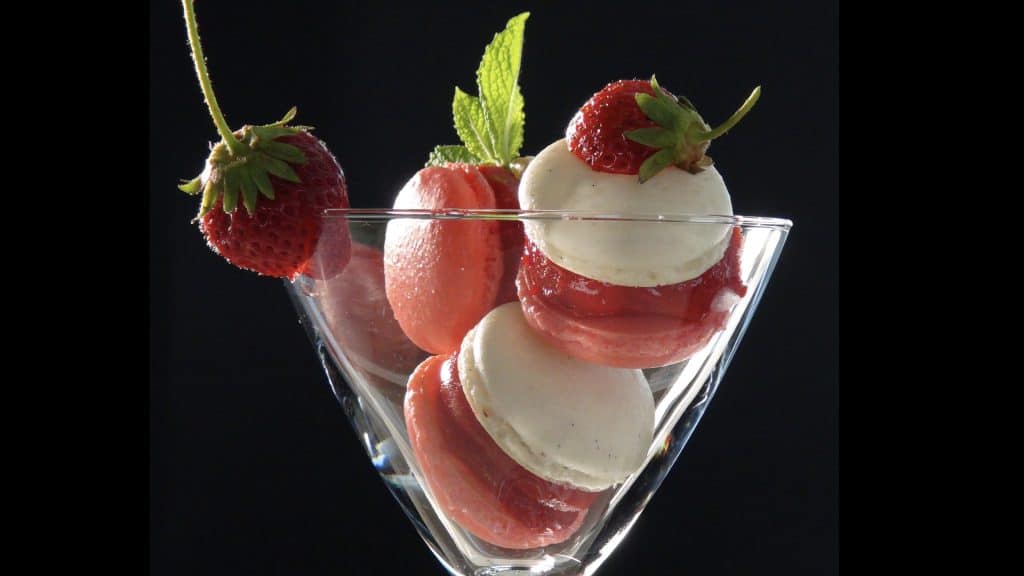The strawberry has captivated imaginations and taste buds for centuries. With its vibrant color and enchanting aroma, this small, fleshy fruit embodies the renewal of spring and evokes childhood memories of sunny days and indulgent desserts. Strawberry recipes abound, from classic strawberry pies and homemade jams to modern and bold culinary creations that take advantage of the fruit’s freshness and versatility.
Rich in health benefits, the strawberry is not only a delight for the senses; it is also a valuable ally for our well-being. Consumed regularly, it helps strengthen the immune system thanks to its high vitamin C content and antioxidant properties. Strawberries also play a role in preventing numerous diseases due to their rich composition in minerals and fibers.
An ideal fruit for those looking to maintain a healthy lifestyle while indulging, it is not only delicious but also a “chameleon ingredient,” adapting well to both sweet and savory preparations.
Strawberries can transform any ordinary dish into a culinary work of art, proving they fully deserve their place in the pantheon of superfoods. By exploring strawberry recipes and discovering the benefits of strawberries, we open ourselves to a world of flavors and nutritional possibilities that enrich our daily diet.
Did you know ? The Strawberry through History
The origins of the strawberry date back to the Neolithic era, when this fruit already grew wild in America, Asia, and the sub-mountainous zones of Western Europe. The wild strawberry, also known as “fraise des bois,” was widespread across these three continents, showcasing the diversity of climates where the plant had established itself. Carried over long distances by birds, this small berry loaded with its tiny seeds was a source of food and pleasure for our Neolithic ancestors.

Over the centuries, the strawberry (genus Fragaria) evolved well beyond its wild form. The Romans, for example, already cultivated strawberries in their gardens for their taste, fragrance, and therapeutic properties. During antiquity, the wild strawberry was prized for its exquisite scent, earning it the Latin name Fragaria vesca. This small piece of strawberry history continued through the ages as it was cultivated and selected to improve its taste qualities and size.
In the Middle Ages, strawberries began to be introduced into European gardens and orchards. Improvements in harvesting were made by replanting the stolons of the wild species. During the Renaissance, the strawberry became a luxury fruit consumed with cream by noblewomen and with wine by men. It was not until the 15th century that strawberries began to be truly commercially cultivated in Europe, thanks to the efforts of the English and the Dutch to obtain larger fruits from the species F. vesca.
The introduction of the wild strawberry into royal gardens, notably by Jean-Baptiste de La Quintinie, gardener to Louis XIV, marked a key step in the domestication and royal appreciation of this fruit. Strawberries were then grown under glass for the great pleasure of the King, who was fond of them, despite his doctor Fagon’s prohibition.
The fascination with strawberries has continued to grow, and today, this fruit is cultivated and cherished worldwide, demonstrating the richness of its history and the diversity of its varieties.
Varieties and seasonality
Strawberries are cultivated worldwide and offer a wide array of varieties, each with its own unique characteristics in terms of taste, texture, and color. Among the most famous, the Gariguette is prized for its elongated shape and sweet-tart flavor, while the Mara des Bois is renowned for its intense aroma reminiscent of the wild strawberry. The Charlotte variety is often chosen for its firm flesh and mild flavor, ideal for fresh desserts and jams.
Varieties like the Plougastel strawberry and the Périgord strawberry are also highly valued in France, each protected by geographical indications that guarantee their quality and origin. Strawberries imported from warmer regions such as Spain or Morocco arrive on European markets during the winter months, thus ensuring availability nearly all year round.
The seasonality of strawberries greatly depends on the variety and the region of cultivation. Generally, the strawberry season begins in spring and can extend into autumn for some everbearing varieties. The Gariguette, for example, is one of the first to appear on the market as early as March and has a relatively short harvest period, making it a highly anticipated variety each year.
The Mara des Bois, on the other hand, is an everbearing variety, meaning it can produce fruit several times throughout the season, often until autumn. This allows consumers to enjoy fresh strawberries for a greater part of the year.
One of the most delectable strawberries in the world is the Japanese variety. In Japan, the strawberry season lasts from early December until late May. The four main strawberry varieties farmed in Japan are Sagahonoka strawberries from Saga Prefecture, Benihoppe strawberries from Shizuoka Prefecture, Tochiotome strawberries from Tochigi Prefecture, and Amaou strawberries from Fukuoka Prefecture. These Japanese strawberries are infamous for their deep red pigment color, lack of hollow centers, often rather sweet flavors, mild acidity, and, ultimately, their expensive price; one fruit can indeed be sold for 10 dollars!
How to choose and store Strawberries?
Choosing quality strawberries is essential to fully enjoy their taste and nutritional benefits. When purchasing, look for fruit that is rather small (an oversized strawberry is a sign of excessive use of fertilizer), and uniformly colored, without any spots or mold. The color should be a vibrant red, a sign of ripeness and freshness. Strawberries should also have a pleasant and sweet aroma, a reliable indicator of their freshness and flavor. It is often best to source them as close to the producers as possible, especially by visiting local market stalls.
Often sold in punnets or crates, this allows you to visually inspect them from all angles. Make sure that the fruits at the bottom do not show signs of deterioration, as this can quickly affect the rest of the contents. Another tip is to check the calyx and stem, which should be green and fresh, indicating that the strawberries were recently picked.
Regarding the storage of strawberries, it is important to keep them in the refrigerator if they are not consumed immediately. To preserve their texture and flavor, wash them only at the time you eat or use them in your preparations. Strawberries easily absorb moisture, which accelerates their deterioration. Keep stems on and soak strawberries in water bath for a minute, grab fruits with large slotted spoon or by hand and spread them in a single layer on a plate covered with paper towels to prevent them from crushing under their own weight.
As for the ideal time to consume strawberries, it often depends on their preparation. For immediate consumption, choose strawberries that are just ripe to ripe. If you plan to use them in a few days, it might be wise to choose slightly less ripe fruits, which will continue to ripen slowly in the refrigerator.
Nutritional values and Health benefits
Strawberries are not just delicious; they are also loaded with essential nutrients that can play a key role in promoting good health. Rich in vitamin C, strawberries even surpass some citrus fruits in their content, making this fruit an excellent ally for boosting the immune system. A 150-gram serving of strawberries can provide more than 150% of the recommended daily intake of this essential vitamin.

In addition to their high vitamin C content, strawberries are a good source of fiber, which helps regulate digestion and maintain a good level of satiety. They also provide a significant amount of minerals such as manganese, folate (vitamin B9), and potassium, which contribute to cardiovascular and bone health.
The antioxidant properties are also recognized due to the high content of phenolic compounds, particularly anthocyanins, which give them their characteristic red color. These antioxidants help reduce inflammation in the body and may even play a role in preventing chronic diseases.
Research on the nutritional properties of strawberries has also highlighted their potential benefits on mental health, notably by reducing oxidative stress and improving mood. This can be attributed to their ability to modulate certain chemical signals in the brain.
Including strawberries in your diet can thus not only add flavor and color to your meals but also provide a significant boost to your health. Whether consumed fresh, in a smoothie, or incorporated into desserts and salads, strawberries are a nutritious choice that can enhance your overall well-being.
My favorite Strawberry recipes














Strawberries and aromatic herbs
Strawberries pair exceptionally well with a variety of aromatic herbs, offering flavor combinations that are both surprising and delightful. This fusion can transform simple dishes into refined gastronomic creations, and can even add a unique twist to strawberry cocktails.
Basil and Strawberries: This is a classic duo in the culinary world. Basil, with its peppery and slightly sweet notes, perfectly complements the natural sweetness of strawberries. This pairing is often used in summer salads, desserts like sorbets, or refreshing beverages.
Mint and Strawberries: The freshness of mint intensifies the taste of strawberries, bringing a burst of freshness that is ideal for hot summer days. Use this mix in smoothies, strawberry mojitos, or even in fresh fruit dishes.
Cilantro and Strawberries: For those who enjoy bolder flavors, cilantro offers an intriguing contrast with strawberries. This combination is especially popular in fruit salsas or as a topping for spicy fish or chicken dishes.
Matcha and Strawberries: A bit less conventional, the combination of green tea, lemon and strawberries can be a culinary revelation like this amazing Strawberry Lemon Tiramisu.
Incorporating aromatic herbs with strawberries is not just a matter of taste but also health. Herbs increase the nutrient content of the dish while adding layers of flavor without additional calories. Whether you are preparing a dessert, a drink, or a main dish, adding herbs can transform your strawberry recipes into culinary works of art.
Culinary tips
Strawberries are incredibly versatile in the kitchen, and there are numerous creative ways to use them beyond just desserts. Whether sautéed, grilled, or used in savory dishes, strawberries can add a touch of sophistication to your meals.
Sautéed Strawberries: Quickly sautéing strawberries with a bit of sugar or honey or balsamic vinegar can enhance their sweetness and create a perfect accompaniment for warm desserts like pancakes or vanilla ice cream. The heat lightly caramelizes the natural sugars in the strawberries, offering an unexpected depth of flavor.
Grilled Strawberries: Strawberries can also be grilled, for example on skewers with other fruits, for a perfect summer dessert. Grilling strawberries enhances their sweetness while adding a subtle smoky note. Serve them with a scoop of ice cream or Greek yogurt for a refreshing contrast.
Strawberries in Savory Dishes: Incorporating strawberries into salads or savory dishes might seem unconventional, but their natural sweetness perfectly complements savory flavors. Try sliced strawberries in a salad with goat cheese, nuts, and a balsamic dressing, or use them as a topping for a savory tart with blue cheese and caramelized onions.
Using strawberries in cooking is not limited to their flavor contribution; they can also add an attractive visual element to your dishes. Their vibrant red color can make any dish a feast for the eyes, which is particularly useful in contexts where the appearance of the dish is paramount.
Growing Strawberries
Growing strawberries requires special attention, as they need optimal growing conditions to develop their characteristic taste and texture. Cultivation techniques vary widely depending on the varieties of strawberries and the climate, ranging from open-field cultivation to growing strawberries in greenhouses or under tunnels. However, it is a fruit that you can potentially grow in your own garden or greenhouse.
Strawberry Season: The strawberry production season varies by region. Generally, the season starts in spring and can extend into autumn for everbearing varieties. Understanding the strawberry season in your area can help you plan your purchases to enjoy the freshest fruits and support the local economy.
Planting Strawberries: For those looking to grow their own strawberries, it is important to choose the right variety suited to their climate and available space. Strawberries can be planted in the ground, in planters, or even in hanging pots, making them accessible even for those without a garden. Consult with your local suppliers; they can provide valuable advice.
Strawberries are not just a summer delight; they embody a rich tradition of cultivation, a diversity of varieties, and a multitude of culinary uses. Whether you prefer to enjoy them fresh, incorporate them into innovative recipes, or use them for their health benefits, strawberries offer something for everyone. By choosing the right varieties for your needs and purchasing them at the best time of their season, you can fully enjoy this exceptional fruit.
Strawberries offer a fabulous palette of flavors and possibilities. From the garden to the table, they inspire chefs, pastry chefs, and cooking enthusiasts around the world. I hope that with all this information, you will experiment with the different facets of this fruit and dare to venture into original and tasty preparations. Bon appétit!
